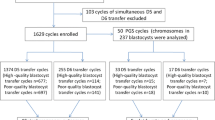Abstract
Purpose
To examine the possibility of freezing human embryos at late cleaved stages (morula or blastocyst stage), we cryopreserved human embryos 5 days (day 5) or 6 days (day 6) after insemination and investigated their developmental potential after thawing.
Materials and Methods
One hundred nineteen morphologically good-quality human embryos from 43 women undergoing in vitro fertilization treatment between 1991 and 1992 were frozen using dimethylsulfoxide as a cryoprotectant. The embryos were cryopreserved for 5 to 30 months. After thawing they were then cultured in vitro for 24 hr to investigate their developmental potential. Survival rates and developmental rates were morphologically assessed after 24 hr of in vitro culture.
Results
Developmental rates were significantly (P <0.01 or P <0.05) lower than survival rates at every developmental stage. There was no difference in total survival rates between embryos frozen 5 days after insemination (78.2%; 54/69) and embryos frozen 6 days after insemination (70.0%; 35/54). However, the developmental rates after 24 hr of culture was significantly (P <0.05) lower for embryos frozen 6 days after insemination (6.0%; 3/50) than for embryos frozen 5 days after insemination (18.8%; 13/69). Only two embryos developed into fetuses after transfer into the uterus (1.7%; 2/119).
Conclusions
From the results, the developmental potential of frozen-thawed human blastocysts was found to be significantly reduced, even though the blastocysts were of morphologically good quality. Longer in vitro exposure of embryos appears to reduce their developmental potential.
Similar content being viewed by others
References
Cohen J, De Van GW, Elser CW, Fehilly, CB, Kort, HI, Massey, JB, Turner TG Jr: Cryopreservation of zygotes and early cleaved human embryos. Fertil Steril 1988;49:283–289
Trounson A, Mohr L: Human pregnancy following cryopreservation, thawing and transfer of an eight-cell embryo. Nature 1983;305:707–709
Testart J, Lassalle B, Belaish-Allart J, Hazout A, Forman R, Rainhor JD, Frydman R: High pregnancy rate after early embryo freezing. Fertil Steril 1986;46:268–272
Bilton RJ, Moore NW: Successful transport of frozen cattle embryos from New Zealand to Australia. J Reprod Fert 1977;50:363–364
Willadsen S, Polge C, Rowson LEA: The viability of deepfrozen cow embryos. J Reprod Fert 1973;52:391–393
Hartshorne GM, Elder K, Crow J, Dyson H, Edwards RG: The influence of in-vitro development upon post-thaw survival and implantation of cryopreserved human blastocysts. Hum Reprod 1991;6:136–141
Noda Y, Goto Y, Umaoka Y, Shiotani M, Nakayama T, Mori T: Culture of human embryos in alpha modification of Eagle's medium under low oxygen tension and low illumination. Fertil Steril 1994;62:1022–1027
Friedler S, Giudice LC, Lamb EJ: Cryopreservation of embryos and ova. Fertil Steril 1988;49:743–764
Lassalle B, Testart J, Renard JP: Human embryo features that influence the success of cryopreservation with the use of 1,2-propandiol. Fertil Steril 1985;44:645–651
Chedid S, Van den Abbeel E, Van Steirteghem AC: Effect of cryopreservation on survival and development of interphaseand mitotic-stage 1-cell mouse embryos. Hum Reprod 1992;7:1451–1456
Renard JP, Babinet C: High survival of mouse embryos after rapid freezing and thawing inside plastic straws with 1,2-propanediol as cryoprotectant. J Exp Zool 1984;230:443–448
Cohen J, Simon RF, Edwards RG, Fehilly CB, Fishel SB: Pregnancies following the frozen storage of expanding human blastocysts. J Vitro Fert Embryo Transfer 1985;2:59–64
Trounson A, Sjoblom P: Cleavage and development of human embryos in vitro after ultrarapid freezing and thawing. Fertil Steril 1988;50:373–376
Hartshorne GM, Elder K, Crow J, Dyson H, Edwards RG: The influence of in-vitro development upon post-thaw survival and implantation of cryopreserved human blastocysts. Hum Reprod 1991;6:136–141
Fehilly CB, Cohen J, Simons RF, Fishel SB, Edwards RG: Cryopreservation of cleaving embryos and expanded blastocysts in the human: A comparative study. Fertil Steril 1985; 44:638–644
Menezo Y, Nicollet B, Heraut N, Andre A: Freezing cocultured human blastocysts. Fertil Steril 1992;58:977–980
Hartshorne GM, Wick K, Elder K, Dyson H: Effect of cell number at freezing upon survival and viability of cleaved embryos generated from stimulated IVF cycles. Hum Reprod 1990;5:857–861
Edwards RG, Hollands P: (1988) New advances in human embryology: Implication of the preimplantation diagnosis of genetic disease. Hum Reprod 1988;3:549–556
Schatten G, Simerly C, Schatten H: Microtubule configuration during fertilization, mitosis, and early development in the mouse and the requirement for egg microtubule-mediated motility during mammalian fertilization. Proc Natl Acad Sci USA 1991;82:4152–4156
Keenan D, Cohen J, Suzman M, Wright G, Kort H, Massey J: Stimulation cycles suppressed with gonadotrophinreleasing hormone analog yield accelerated embryos. Fertil Steril 1991;55:792–796
Demoulin A, Jouan C, Gerday C, Dubois M: pregnancy rates after transfer of embryos obtained from different stimulation protocols and frozen at either pronucleate or multicellular stage. Hum Reprod 1991;6:799–804
Dokras A, Sargent IL, Barlow DH: Human blastocyst grading: An indicator of development potential? Hum Reprod 1993;12:2119–2127
Bongso A, Ng SC, Sathananthan H, Lian NP, Rauff M, Ratnam S: Improved quality of human embryos when cocultured with human ampullary cells. Hum Reprod 1989;4:706–713
Dokras A, Sargent IL, Ross C, Gardner RL, Barlow DH: The human trophectoderm biopsy and secretion of chorionic gonadotrophin. Hum Reprod 1991;6:1143–1151
Author information
Authors and Affiliations
Rights and permissions
About this article
Cite this article
Nakayama, T., Goto, Y., Kanzaki, H. et al. Developmental potential of frozen-thawed human blastocysts. J Assist Reprod Genet 12, 239–243 (1995). https://doi.org/10.1007/BF02212925
Received:
Accepted:
Issue Date:
DOI: https://doi.org/10.1007/BF02212925



